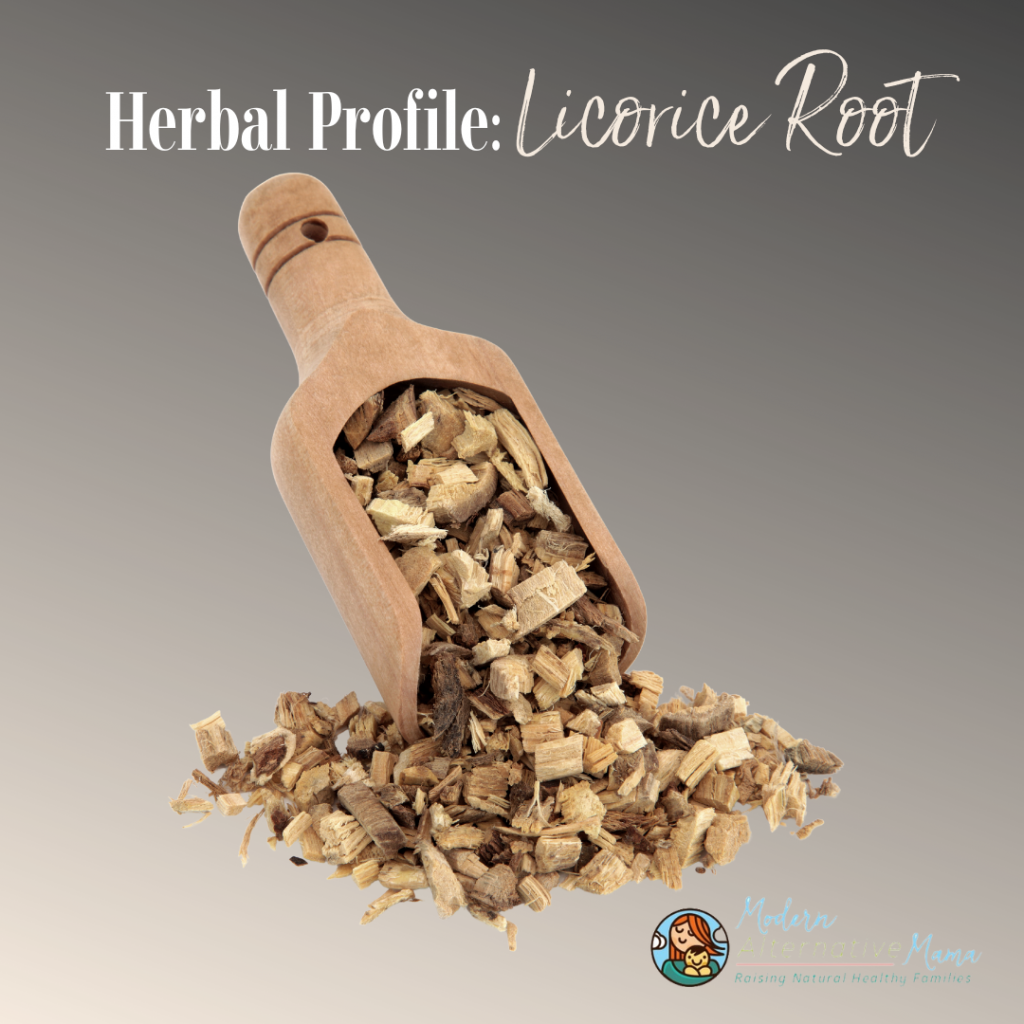What is Licorice
Licorice root, often referred to as Liquorice, or its scientific name Glycyrrhiza glabrab is a part of the Fabaceae or pea family. Licorice is a flowering, herbaceous perennial legume native to Europe, Asia, and North America. This brownish/red flowering legume grows on a tan 3-foot stem with 1-inch bluish/purple flowers and 3-6 inch green leaves that are soft to the touch (2).
Health Benefits of Licorice
Licorice’s root produces an intensely sweet compound used in teas and candies, but it’s also brimming with health benefits including, but not limited to:
May Reduce Acid Reflux & Indigestion
Licorice root is also said to affect your digestion positively. Licorice root extract has been used to relieve symptoms of indigestion, such as acid reflux, upset stomach, and heartburn. In human studies, taking a 75 mg licorice capsule twice daily for 30 days resulted in significant improvements in symptoms compared with a placebo (3).
Aside from indigestion relief, licorice root may alleviate gastroesophageal reflux disease (GERD) symptoms, such as acid reflux and heartburn. In an 8-week human study, a low dose of glycyrrhetinic acid in combination with standard treatment resulted in significant improvements in GERD symptoms (4). A 2-year human study found daily licorice root was more effective at reducing GERD symptoms than commonly used antacids (5).
May Help Manage Peptic Ulcers
Peptic ulcers can be gastric or duodenal ulcers and are open sores that develop on the lining of your stomach and the upper portion of your small intestine as a result of Helicobacter pylori (H. pylori) or long-term use of nonsteroidal anti-inflammatory drugs (6). In animal studies, 91 mg of licorice root extract per pound of body weight protected mice against peptic ulcers better than omeprazole, an over-the-counter peptic ulcer medication (7). Although more human studies are needed, a 2-week study showed that consuming licorice extract alongside a standard treatment significantly reduced the presence of H. pylori (8).
May Provide Menopause Symptom Relief
Menopause transpires when estrogen decreases and is characterized by a point in time 12 months after a woman’s last menstrual cycle. In the years leading to menopause, women may have changes in their monthly cycles, hot flashes, or other uncomfortable symptoms (9). Thanks to licorice root’s estrogen receptor modulators, and estrogenic and anti-estrogenic activities, licorice root may help (10). Although research is limited, licorice root extract has been suggested as a remedy for hot flashes during menopause (11).
May Improve Fasting Blood Sugar & Diabetes
As of 2020, 34.2 million (1 in 10) Americans have diabetes, and another 88 million (1 in 3) Americans have prediabetes (12). Although studies are limited, licorice root may help. Licorice extracts, five flavonoids, and three triterpenoids isolated from licorice possess great antidiabetic activities in vivo and in vitro (13). In animal studies, daily intake of licorice root extract for 60 days resulted in significant improvements in blood sugar levels and kidney health (14).
May Support Respiratory Health
More than 34 million Americans live with chronic lung diseases like asthma, COPD, emphysema, or chronic bronchitis (15). Thankfully, licorice root’s anti-inflammatory and antimicrobial properties may aid upper respiratory conditions. Animal studies have found licorice root extract helps relieve asthmatic symptoms, but most studies are alongside the use of pharmaceuticals (16,17,18). Although more human studies are needed, the currently available studies showed similar results (19). Additionally, test-tube studies found licorice root tea and extract protected against strep throat (20).
May Support Oral Health
Dental cavities and gum infections are widespread, bacteria-caused oral diseases (21). Mutans streptococci and lactobacilli are strong acid producers and hence cause an acidic environment creating the risk for cavities (22). Licorice root’s antibacterial properties may have an important role in preventing cavities. In test-tube studies, licorice root extract effectively protected against bacteria commonly linked to cavities and tooth decay (23,24). In human studies, researchers gave 66 preschool-aged kids lollipops containing 15 mg of licorice root twice per day, during the school week, for three weeks. They found consuming the lollipops significantly reduced the number of Streptococcus mutans bacteria (25).
May Aid in Weight Loss
Weight management is a challenge for most people in the U.S., with more than 70% of American adults being overweight (26). Excess body weight is a common contributor to type 2 diabetes, the most common type of diabetes. Being overweight increases your risk for type 2 diabetes, heart disease, and stroke (27). There is some conflicting information on this benefit, but some studies indicate that licorice root extract lowers body mass index (BMI) and supports weight loss (28), while others do not (29).
Anticancer Properties
Statistics say that 158.3 of every 100,000 individuals will die from cancer (30), but what if they didn’t have to? Thanks to licorice root’s numerous plant compounds with antioxidant and anti-inflammatory effects, studies have found its protective effects against certain types of cancer (31). For instance, licorice root extract’s compounds have chemoprotective effects linked to slowing or preventing cell growth in skin, breast, colorectal, and prostate cancers (32,33,34).
Safety Concerns
The mainstream cautions that there isn’t enough reliable information available about taking licorice when breastfeeding and recommends staying on the safe side and avoiding use. There is also caution about how much licorice root to take and for how long (35). Contrarily, trusted herbalist Richard Whelan states that aside from several key areas of caution, much of the worry about the safety of Licorice is unnecessary and, when used with care and respect, Licorice is an extremely safe herb to use for the young and old, during pregnancy or while breastfeeding.
Richard Whelan also states most people will need to take between 20 to 30 grams a day before they are at risk of side effects from Licorice. That said, a person with high blood pressure, impaired kidney function, or a high salt diet could get some adverse responses to Licorice with as little as 5 grams daily (36).
How to Use Licorice
You can find licorice root in dried bulk, teas, capsules, powders, extracts, and even herbal tinctures. Tinctures always contain the most concentrated amount of herbs. Teas are also an option. If you’re a DIY person, some great starter recipes are:
Follow the recommendations of any supplement; some of my recommendations include:
- Earthley’s Eye Serum combines blueberry seed, rosehip seed, prickly pear, comfrey, calendula, ginger, and licorice root to improve circulation and reduce inflammation. Smooth wrinkles, nourish delicate skin, and banish dark circles with Earthley’s Eye Serum!
- Earthley’s Lunamore (“moon love”) is for special metabolic support and a woman’s moon cycle. This tincture provides herbal support for hormone balance, helps to reduce cramps and cysts, and supports healthy blood sugar levels.
- Earthley’s Natural Balance is a tincture for women struggling with the ups and downs of hormones. This herbal remedy can help steady hormone levels and provide you with increased energy, calmness, and better quality sleep.
- Earthley’s Thyroid Support is an herbal formula for thyroid support and total body wellness. The herbs include ashwagandha, amla berry, licorice root, Brahmi leaf, and milk thistle seed. It is rich in vitamin C and supports a healthy liver and stress response.
Disclaimer: This post is not intended as medical advice. These statements have not been evaluated by the FDA, and nothing in this post is intended to diagnose, treat, or cure anything. If you have questions, please do your own research or seek advice from a health professional.







